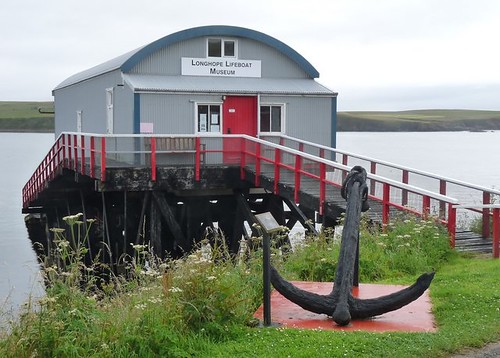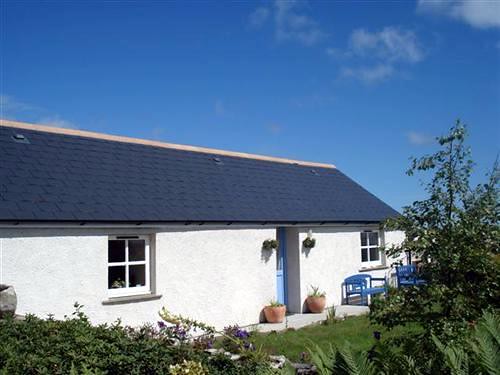Isle of Hoy
Guide to the Isle of Hoy in the Orkneys. Hoy is more reminiscent of the Scottish Highlands with its hills and is of course home to the famous Old Man of Hoy...
Local Phone code: +44 (0)1856
To the southwest of the Mainland is Hoy, the second largest of the Orkney islands. The name is derived from the Norse Ha-ey, meaning High Island, which is appropriate as much of the island is more reminiscent of the Scottish Highlands than Orkney, with only the southern end being typically low and fertile.
Orkney's highest point, Ward Hill (1,571 ft) is in the north of the island, and the north and west coasts are bounded by spectacular cliffs. At St John's Head the sheer cliffs rise out of the sea to a height of 1,150 ft, the highest vertical cliffs in Britain. The island is most famous for its Old Man of Hoy, a great rock stack rising to 450 ft. This northern part of Hoy forms the North Hoy RSPB Reserve which has a variety of habitats ranging from woodland to tundra-like hill-tops and sea cliffs. The reserve is home to a huge variety of birds including great skuas and Arctic skuas, Manx shearwaters and puffins. On the hills there are red grouse, curlews, golden plovers and dunlins, as well as peregrine falcons, merlins, kestrels and even golden eagles. Mountain hares are quite common and, if you are very lucky, you can also see otters along the Scapa Flow coastline.
Region
OrkneysTravel Directions to Isle of Hoy
There are 2 ferry services to Hoy, both run by Orkney Ferries, Tel. 850624. The passenger ferry sails three times a day ( Mon-Fri) and twice on Fri evenings, twice daily Sat and Sun. There is also a car and passenger service between Houton and Lyness and Longhope up to 6 times daily ( Mon to Sat).
Transport on Hoy is limited to a minibus between Moaness Pier and Rackwick 01856-791315. There is no car hire anymore since Halyel closed down.
Since 2009, there is a bus service called the Hoy Hopper - details of schedule, etc is here (pdf document) Runs 26th May to 24th September on Wednesdays, Thursdays and Fridays. (some details are at the bottom of the page)
A passenger ferry sails between Stromness and Moaness Pier in the north (30 mins) 3 times a day Mon-Fri and twice on Fri evenings, twice daily Sat and Sun. There's a reduced winter service (mid-Sep to mid-May). There's also a car and passenger service between Houton and Lyness and Longhope (45 mins) up to 6 times daily (Mon-Sat). There's a limited Sun service from mid-May to mid-Sep.
Local Sights & Activities for Isle of Hoy
Hoy's great attraction is its many excellent walking opportunities. A minibus runs between Moaness Pier, where the ferry from Stromness docks (see Transport below), and Rackwick, on the opposite side of the island, but it's a lovely two-hour walk by road through beautiful Rackwick Glen, once populated by crofters and fishermen, but now quiet and isolated. On the way you'll pass the Dwarfie Stone, a huge, lonely block of sandstone which is the only rock-cut tomb in Britain, dating from around 3000 BC. Be careful, though, because according to Sir Walter Scott this is the residence of the Trolld, a dwarf from Norse legend. On your return you can take a different route through a narrow valley between the Cuilags (1,421 ft) and Ward Hill and Berriedale Wood, the most northerly woodland in Britain. The most popular walk on Hoy is the spectacular three-hour hike from Rackwick to the cliffs facing the Old Man of Hoy. The path climbs steeply westwards from the old crofting township, then turns northwards before gradually descending to the cliff edge.
Lyness & South Walls
On the southeast coast of the island is Lyness, site of a large naval base during both world wars when the British fleet was based in Scapa Flow. Many of the old dilapidated buildings have gone, but the harbour area is still scarred with the scattered remains of concrete structures, and there's also the unattractive sight of the huge oil terminal on Flotta. Lyness has a large Naval Cemetery, last resting place of those who died at Jutland, of Germans killed during the scuttle and of the crew of HMS Royal Oak. The old pump house opposite the new ferry terminal is now the Scapa Flow Visitor Centre, a fascinating naval museum with old photographs, various wartime artefacts, a section devoted to the scuttling of the German Fleet, and an audio-visual feature on the history of Scapa Flow. Well worth a visit. Info - Mid-May to mid-Sep Mon-Sat 0900-1630, Sun 1030-1545; Jul and Aug Mon-Sat 0900-1630, Sun 0945-1800; mid-Sep to mid-May Mon-Fri 0900-1630. Adult £2. Tel. 791300.
At South Walls, overlooking Longhope Bay, is Hackness Martello Tower and Battery which, along with another tower on the north side at Crockness, was built in 1815 to protect British ships in Longhope Bay against attack by American and French privateers while they waited for a Royal Navy escort on their journey to Baltic ports.
Info - The tower is open to the public. If locked, a sign on the door will tell you where to get the key from.
Hoy Hopper Leaflet Details
Betty Corrigall’s Grave
Betty, a young girl from Lyness, found herself pregnant by a visiting sailor. She was so ashamed and embarrassed by her predicament that she took her own life. She was buried away from hallowed ground on the parish boundary. Surely one of Britain’s loneliest graves.
Scad Head Viewpoint and Lyrawa viewpoint
The site of a wartime anti aircraft battery. From both of these viewpoints you experience the wonderful panorama of Scapa Flow, Orkney mainland and surrounding islands.
Lyness Naval Cemetery
Here rest the heroes from some of the most famous incidents in modern history; HMS Hampshire sunk by a mine off Birsay, with the loss of Lord Kitchener (1916); HMS Vanguard which blew up while at anchor off Flotta (1917) and the Royal Oak, torpedoed in Scapa Flow (1939). The cemetery also contains the graves of 14 sailors of the German Navy - the High Seas Fleet was interned at Scapa Flow after the 1918 Armistice.
Lyness Naval base and Interpretation Centre
Scapa Flow was a key anchorage for the Royal Navy in both World Wars. The pump house at Lyness naval base has been converted into an interpretation centre reliving the history of the base.
Martello Towers and Longhope Battery
These two towers, constructed between 1813 and 1815 at the height of the Napoleonic War. They were again used during WW1 and were renovated in 1966. Open for visitors.
Longhope Lifeboat Station Museum
Situated at Brims in South Walls, Longhope Lifeboat station opened in 1834 and has saved over 500 lives. The boat shed is now being converted into a museum – to view, telephone (01856) 701332. The present day lifeboat is afl oat at Longhope Pier.
Local Visitor Attractions
Isle of Hoy Hotels & Accommodation
There's not much accommodation in the north of the island, except for the two SYHA hostels. The larger of the two, F Hoy Youth Hostel, is about a mile from Moaness Pier. It's open from May-Sep. The smaller hostel is F Rackwick Youth Hostel in Rackwick Glen (open mid-Mar to mid-Sep). To book ahead for both hostels, contact Orkney Council, Tel. 873535, ext 2404. Near the pier and post office is the Hoy Inn, Tel. 791313, a bar and restaurant which serves good food (closed Mon). There's also an RSPB information centre here.
There are a few very good B&Bs in the south of the island. South of Lyness is E Stoneyquoy, Tel./Fax. 791234, www.visithoy.com The owner, Louise Budge, also runs guided tours of the island. On the other side of the bay in Longhope is E-F Burnhouse, Tel. 701263. Also in Longhope is the E-F Old Custom House, Tel. 701358. Near the ferry terminal in Lyness is E The Hoy Hotel, Tel. 791377. Open Apr-Oct, which serves meals.
The Anchor Bar, Tel. 791356, in Lyness serves lunches.
The only shop is in Longhope.
Self Catering is available at Cantick Head Lighthouse Cottages (01856 701255) - website



